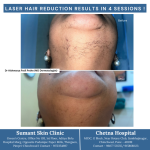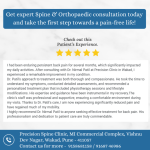Frozen Shoulder, also known as Adhesive Capsulitis, is one of the most common causes of shoulder pain and restricted movement in adults. Many people initially ignore the early signs—mild stiffness, difficulty lifting the arm, or pain while sleeping—until the condition becomes severe enough to affect daily life. Frozen Shoulder often develops gradually, but with timely treatment, recovery can be much faster than most patients expect.
In this detailed guide, we’ll explore what Frozen Shoulder is, why it happens, common symptoms, treatment options, and how patients can achieve complete recovery.
What Is Frozen Shoulder?
Frozen Shoulder is a condition where the shoulder capsule—a soft tissue that surrounds the shoulder joint—becomes inflamed, thickened, and stiff, restricting the arm’s movement. The shoulder joint works like a ball-and-socket system. When the capsule tightens, it limits how far and how comfortably the arm can move, resulting in pain and stiffness.
Unlike a normal shoulder strain or injury, Frozen Shoulder is a progressive condition. It does not improve on its own without medical attention. The condition can last months to years if left untreated.
Who Is at Risk?
Frozen Shoulder can affect anyone, but certain groups are more prone to developing it.
1. People With Diabetes
Diabetic patients are at significantly higher risk. Up to 30–40% of people with diabetes may develop Frozen Shoulder at some point in their life.
2. Those With Thyroid Disorders
Hypothyroidism and hyperthyroidism are both known to contribute to stiffness and shoulder inflammation.
3. Individuals With a History of Shoulder Injury
Falls, fractures, rotator cuff injuries, or shoulder surgeries can trigger the condition, especially if arm movements were restricted afterward.
4. People With Prolonged Immobility
Keeping the arm still for a long time—such as after an injury or surgery—can cause the capsule to stiffen.
5. Age and Gender
Frozen Shoulder commonly affects people between 40 and 60 years, and it is more commonly seen in women.
Understanding these risk factors is important because early diagnosis significantly improves recovery.
How Does Frozen Shoulder Develop? – The 3 Phases
Frozen Shoulder typically progresses through three well-defined stages. Each stage has unique symptoms and duration.
1. Freezing Phase (Painful Phase)
Duration: 2–9 months
This is the initial stage where pain develops gradually. Night pain is common, especially when lying on the affected side. Movement becomes difficult and painful, and stiffness slowly increases.
2. Frozen Phase (Stiff Phase)
Duration: 4–12 months
During this stage, pain may reduce, but stiffness becomes severe. Simple tasks like reaching overhead, combing hair, wearing clothes, or reaching behind the back become extremely difficult.
3. Thawing Phase (Recovery Phase)
Duration: 6–24 months
Movement gradually improves. With proper treatment, this stage can be significantly shortened. Without treatment, the shoulder may remain stiff for a long time.
Common Symptoms of Frozen Shoulder
Recognizing the symptoms early helps patients seek timely medical care. Key symptoms include:
- Persistent dull or aching pain in the shoulder
- Sharp pain on certain movements
- Difficulty lifting the arm
- Inability to reach overhead or behind the back
- Pain while sleeping, especially on the affected side
- Stiffness that worsens with time
- Restricted range of motion in all directions
Patients often describe the shoulder as “locked” or “stuck,” making everyday activities challenging.
How Is Frozen Shoulder Diagnosed?
A clinical evaluation by an Orthopaedic Specialist is usually sufficient to diagnose Frozen Shoulder. The doctor will examine the shoulder’s movement and assess the level of stiffness and pain.
Sometimes, imaging tests like X-rays, Ultrasound, or MRI may be recommended to rule out other conditions such as arthritis, rotator cuff tear, or impingement.
Treatment Options for Frozen Shoulder
The good news is that most patients recover well with the right treatment. Treatment aims to reduce pain, improve mobility, and restore strength.
1. Medications
Anti-inflammatory medicines help control pain and swelling, especially in the early stages.
2. Physiotherapy
This is the most important part of treatment. A structured physiotherapy program focuses on:
- Stretching tight tissues
- Improving joint mobility
- Strengthening shoulder muscles
- Increasing range of motion
Patients who follow physiotherapy regularly show significant improvement.
3. Hot and Cold Therapy
Alternating heat and ice can reduce pain and promote blood circulation, aiding mobility.
4. Steroid Injections
Image-guided steroid injections help reduce inflammation and provide quick pain relief, especially in the Freezing Phase.
5. Hydrodilatation
A minimally invasive procedure where fluid is injected into the shoulder capsule to stretch and loosen it. It provides quick relief for many patients.
6. Arthroscopic Capsular Release (Advanced Treatment)
For severe cases where physiotherapy is not effective, Arthroscopic Capsular Release is recommended.
This minimally invasive surgery involves using a small camera and tools to:
- Release the tight capsule
- Remove scar tissue
- Increase shoulder movement immediately
Recovery after this procedure is usually fast, and patients regain mobility quickly with guided physiotherapy.
Home Care Tips to Speed Up Recovery
✔ Gentle Stretching
Regular stretching under professional guidance helps prevent worsening stiffness.
✔ Maintain Activity
Avoid complete rest; controlled movements are essential.
✔ Apply Heat Before Exercise
Warmth relaxes muscles and reduces pain while stretching.
✔ Avoid Heavy Lifting
Straining the shoulder can worsen the condition.
✔ Continue Physiotherapy
Consistency is key for long-term recovery.
Can Frozen Shoulder Be Prevented?
Prevention is possible in many cases. Here’s how:
- Keep moving after injuries or surgeries
- Perform shoulder mobility exercises daily
- Manage diabetes effectively
- Avoid keeping the arm immobile for long
- Strengthen shoulder muscles regularly
When Should You Consult an Orthopaedic Surgeon?
Seek medical advice if:
- Shoulder pain lasts more than 2–3 weeks
- Stiffness is restricting daily activities
- Pain worsens at night
- You cannot lift or rotate your arm normally
- Home remedies are not helping
Early treatment gives faster recovery and prevents long-term stiffness.
Conclusion
Frozen Shoulder is a painful and frustrating condition, but with timely treatment and proper care, most patients recover fully. Understanding the symptoms, seeking early diagnosis, and following a structured treatment plan—especially physiotherapy—are the keys to successful recovery.
If shoulder pain or stiffness is affecting your daily life, consult an Orthopaedic Specialist for accurate diagnosis and personalised treatment.













